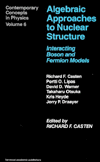Algebraic Approaches to Nuclear Structure
This book is devoted to algebraic models and their applications. It presents a simple, but thorough, pedagogic approach, starting from the most elementary ideas and building up to the most recent results of advanced theories. The book is designed for a graduate level treatment.
1137103434
Algebraic Approaches to Nuclear Structure
This book is devoted to algebraic models and their applications. It presents a simple, but thorough, pedagogic approach, starting from the most elementary ideas and building up to the most recent results of advanced theories. The book is designed for a graduate level treatment.
74.99
In Stock
5
1

Algebraic Approaches to Nuclear Structure
570
Algebraic Approaches to Nuclear Structure
570
74.99
In Stock

Product Details
| ISBN-13: | 9783718605385 |
|---|---|
| Publisher: | Taylor & Francis |
| Publication date: | 07/20/1993 |
| Series: | Contemporary Concepts in Physics , #6 |
| Pages: | 570 |
| Product dimensions: | 6.00(w) x 9.00(h) x (d) |
About the Author
From the B&N Reads Blog
